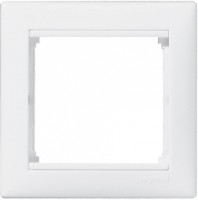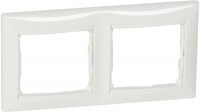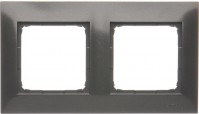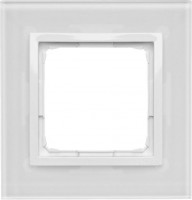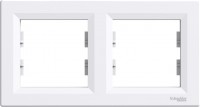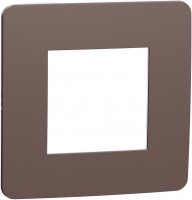Socket & Switch Plates Legrand
All Socket Plates Advanced filters → |
You might be interested in
Socket & Switch Plates: specifications, types
Number of posts
A post is a separate socket for an outlet or a switch provided in the frame. Accordingly, the number of posts is the total number of devices for which the frame is designed. We emphasize that in this case we mean the standard, full size of the socket or switch; if the frame has the ability to install products of a “half” size, the number of modules is additionally specified for it (see below).
Note that sockets are most often installed one at a time, a maximum of two in one frame. A similar arrangement is also popular among switches, however, more spacious solutions are quite often relevant for them — for three, four, and even five or even six posts. Also, in most cases, nothing prevents the use of a capacious frame for sockets, or even for combined placement — sockets in combination with switches.
Note that sockets are most often installed one at a time, a maximum of two in one frame. A similar arrangement is also popular among switches, however, more spacious solutions are quite often relevant for them — for three, four, and even five or even six posts. Also, in most cases, nothing prevents the use of a capacious frame for sockets, or even for combined placement — sockets in combination with switches.
Number of modules
The number of modules provided in the frame design.
If this parameter is indicated in the characteristics, it means that the frame was originally designed for the possibility of installing sockets and switches of a “half” size (occupying 1/2 of a standard post). In this case, a module is called a seat for one such "half" product. And the number of modules is indicated by two numbers, the first of which indicates the number of posts, and the second — the number of modules in each post (usually 2). Based on these data, it is quite possible to determine the total number of modules: for example, marking 3x2 denotes a frame with 3 posts, each of which can accommodate 2 modules, and the total number of modules is 3 * 2=6.
Note that frames with this feature are usually quite compatible with standard, full-size frames / switches.
If this parameter is indicated in the characteristics, it means that the frame was originally designed for the possibility of installing sockets and switches of a “half” size (occupying 1/2 of a standard post). In this case, a module is called a seat for one such "half" product. And the number of modules is indicated by two numbers, the first of which indicates the number of posts, and the second — the number of modules in each post (usually 2). Based on these data, it is quite possible to determine the total number of modules: for example, marking 3x2 denotes a frame with 3 posts, each of which can accommodate 2 modules, and the total number of modules is 3 * 2=6.
Note that frames with this feature are usually quite compatible with standard, full-size frames / switches.
Mounting position
Mounting position for which the frame was originally designed.
Universal products that allow both horizontal and vertical installation are usually universal and for their intended purpose and can be used with both sockets and switches. However, their main purpose is usually sockets; at the same time, a standard socket, usually, can also be fixed in the frame in any position — with holes horizontally or vertically. But if a specific location option is indicated for the frame — horizontal or vertical — this usually means that this model was originally designed for switches. Non-standard installation of such products is technically quite possible, but not justified from the point of view of convenience: in such a case, the switches placed in the frame will be turned 90 ° to the side.
Universal products that allow both horizontal and vertical installation are usually universal and for their intended purpose and can be used with both sockets and switches. However, their main purpose is usually sockets; at the same time, a standard socket, usually, can also be fixed in the frame in any position — with holes horizontally or vertically. But if a specific location option is indicated for the frame — horizontal or vertical — this usually means that this model was originally designed for switches. Non-standard installation of such products is technically quite possible, but not justified from the point of view of convenience: in such a case, the switches placed in the frame will be turned 90 ° to the side.
Cutout shape
The shape of the cutout for the socket or switch — in other words, the shape of the post (posts) that the frame is equipped with.
Most modern built-in sockets and switches are made rectangular (square); as a result, it is this form of cutout that is most popular in the frames for such equipment. Round cutouts are much less common, many frames with this feature are designer models designed for sockets and switches in the original design.
Most modern built-in sockets and switches are made rectangular (square); as a result, it is this form of cutout that is most popular in the frames for such equipment. Round cutouts are much less common, many frames with this feature are designer models designed for sockets and switches in the original design.
External form
The shape of the frame along the outer contours.
The most popular nowadays are the frames of the traditional rectangular shape, with straight lines and clearly defined corners. This form looks good and fits into most interiors, while it is easy to manufacture. Noticeably less common are products of a rounded external shape, with smooth lines; these are, usually, designer models created based on the original appearance. They have no practical advantages over their rectangular counterparts, but they look really unusual and often turn out to be the best choice for an interior in a non-standard design.
The most popular nowadays are the frames of the traditional rectangular shape, with straight lines and clearly defined corners. This form looks good and fits into most interiors, while it is easy to manufacture. Noticeably less common are products of a rounded external shape, with smooth lines; these are, usually, designer models created based on the original appearance. They have no practical advantages over their rectangular counterparts, but they look really unusual and often turn out to be the best choice for an interior in a non-standard design.
Material
The main material from which the frame is made.
The backing of the frame (the lower part in contact with the wall) is almost always made of plastic. Therefore, as the main material, it is customary to indicate the material from which the upper, outer side is made. This part is often different from the substrate; thermoplastic (ABS plastic) is also often used for it, however, there are other, more expensive and rare options: plexiglass, metal, marble composite and even wood. Here is a description of each of these materials:
— Thermoplastic (ABS-plastic). The most popular frame material nowadays. Plastic is inexpensive and easy to process, while it is quite durable and practical. In addition, almost any shade and coloring can be given to such a surface, including the creation of a fairly reliable imitation of another, more advanced material — metal, stone, etc. in general. However, if the frame is used in normal living conditions, without "extreme" — the first moment is not critical; scratches affect only the appearance of the product (and, again, rarely appear in normal domestic use).
— Plexiglas. In fact, it is a more advanced, durable (and, as a result, expensive) analogue of plastic. In this case, plexiglass is usually made transparent or translucent, so that a plast...ic substrate is visible through it — the colour of this substrate determines the overall shade of the frame. Such products are usually plain, without any special "frills" in the design; on the other hand, the transparent outer material gives them a special style. So this option can be found even in fairly expensive frames; on the other hand, a significant (compared to the same plastic) cost limits the use of plexiglass in relatively simple models.
— Metal. One of the main advantages of the metal is considered to be high strength: it perfectly resists scratches and is able to endure even quite strong blows without consequences. In addition, this material looks stylish and rich — both on its own and with an additional coating applied to it; and when touched, metal is generally more pleasant than plastic, it creates a feeling of solidity. On the other hand, metal frames are not cheap, while the advantages described are rarely fundamental from a practical point of view. Therefore, there are few such products nowadays, for the most part they belong to the premium class and are intended for interiors of the appropriate level.
— Marble composite. An artificial composite material that mimics the appearance and texture of marble; often contains natural stone chips. It has an unusual appearance — with a characteristic pattern on the surface; to the touch is perceived as a very high-quality and solid material; Excellent resistance to scratches, however, it can break from a strong blow. It is natural that the marble composite is quite expensive. So, in general, frames made of this material are classified as designer products, and it is worth paying attention to them in cases where a rich appearance and overall image are no less important than practical properties.
— Wood. Quite a rare material that has an exclusively decorative purpose. Such frames go well with interiors of certain styles (for example, with wooden walls or with rooms in an "eco" design). However, from a practical point of view, they do not have advantages over the same plastic ones, but are noticeably more expensive; in addition, among the plastic frames there are many products that very reliably imitate the appearance of wood. So nowadays, wooden frames are rather exotic, designed for principled adherents of natural materials.
The backing of the frame (the lower part in contact with the wall) is almost always made of plastic. Therefore, as the main material, it is customary to indicate the material from which the upper, outer side is made. This part is often different from the substrate; thermoplastic (ABS plastic) is also often used for it, however, there are other, more expensive and rare options: plexiglass, metal, marble composite and even wood. Here is a description of each of these materials:
— Thermoplastic (ABS-plastic). The most popular frame material nowadays. Plastic is inexpensive and easy to process, while it is quite durable and practical. In addition, almost any shade and coloring can be given to such a surface, including the creation of a fairly reliable imitation of another, more advanced material — metal, stone, etc. in general. However, if the frame is used in normal living conditions, without "extreme" — the first moment is not critical; scratches affect only the appearance of the product (and, again, rarely appear in normal domestic use).
— Plexiglas. In fact, it is a more advanced, durable (and, as a result, expensive) analogue of plastic. In this case, plexiglass is usually made transparent or translucent, so that a plast...ic substrate is visible through it — the colour of this substrate determines the overall shade of the frame. Such products are usually plain, without any special "frills" in the design; on the other hand, the transparent outer material gives them a special style. So this option can be found even in fairly expensive frames; on the other hand, a significant (compared to the same plastic) cost limits the use of plexiglass in relatively simple models.
— Metal. One of the main advantages of the metal is considered to be high strength: it perfectly resists scratches and is able to endure even quite strong blows without consequences. In addition, this material looks stylish and rich — both on its own and with an additional coating applied to it; and when touched, metal is generally more pleasant than plastic, it creates a feeling of solidity. On the other hand, metal frames are not cheap, while the advantages described are rarely fundamental from a practical point of view. Therefore, there are few such products nowadays, for the most part they belong to the premium class and are intended for interiors of the appropriate level.
— Marble composite. An artificial composite material that mimics the appearance and texture of marble; often contains natural stone chips. It has an unusual appearance — with a characteristic pattern on the surface; to the touch is perceived as a very high-quality and solid material; Excellent resistance to scratches, however, it can break from a strong blow. It is natural that the marble composite is quite expensive. So, in general, frames made of this material are classified as designer products, and it is worth paying attention to them in cases where a rich appearance and overall image are no less important than practical properties.
— Wood. Quite a rare material that has an exclusively decorative purpose. Such frames go well with interiors of certain styles (for example, with wooden walls or with rooms in an "eco" design). However, from a practical point of view, they do not have advantages over the same plastic ones, but are noticeably more expensive; in addition, among the plastic frames there are many products that very reliably imitate the appearance of wood. So nowadays, wooden frames are rather exotic, designed for principled adherents of natural materials.
Protection class IP
The degree of protection according to the IP standard indicates how protected the structure is against the ingress of foreign objects and water. In this case, we are talking about how the frame protects the device installed in it (socket or switch).
This parameter is traditionally indicated by a two-digit IP index; the first corresponds to the level of protection against foreign objects and dust, the second — from moisture. However, specifically within the framework of sockets / switches, the degree of such protection is usually small. So, many models are labeled IP20; the first digit "2" in this case corresponds to protection against objects with a diameter of more than 12.5 mm (for example, fingers), and the water resistance "0" means that the product, in principle, is not designed for contact with moisture and does not retain it. And the maximum degree of IP protection that can be found within is IP44: the first “four” means protection against objects more than 1 mm (thick wires and larger objects), and the second one means protection against water splashes from any direction.
Also note that the numbers in this marking can be supplemented with an alphabetic index — it means additional protection against access of foreign objects to dangerous internal parts. A typical example, quite common in frames for sockets / switches, is IP21 D. Recall that the number “2” here means resistance to penetration by objects larger than 12.5 mm, however, the index “D”...indicates that the product additionally protects the socket / switch from wire penetration. (With regard to water protection at level 1, it means resistance to strictly vertical drops of water).
This parameter is traditionally indicated by a two-digit IP index; the first corresponds to the level of protection against foreign objects and dust, the second — from moisture. However, specifically within the framework of sockets / switches, the degree of such protection is usually small. So, many models are labeled IP20; the first digit "2" in this case corresponds to protection against objects with a diameter of more than 12.5 mm (for example, fingers), and the water resistance "0" means that the product, in principle, is not designed for contact with moisture and does not retain it. And the maximum degree of IP protection that can be found within is IP44: the first “four” means protection against objects more than 1 mm (thick wires and larger objects), and the second one means protection against water splashes from any direction.
Also note that the numbers in this marking can be supplemented with an alphabetic index — it means additional protection against access of foreign objects to dangerous internal parts. A typical example, quite common in frames for sockets / switches, is IP21 D. Recall that the number “2” here means resistance to penetration by objects larger than 12.5 mm, however, the index “D”...indicates that the product additionally protects the socket / switch from wire penetration. (With regard to water protection at level 1, it means resistance to strictly vertical drops of water).
Protection class IK
The degree of protection according to the IK standard describes the resistance of the product to impacts and other mechanical influences; Simply put, this parameter characterizes the overall strength of the frame.
The IK protection level is indicated by a two-digit number from 00 (no protection) to 10 (maximum). Each specific level assumes resistance to a certain impact energy. For example, marking IK04 assumes a maximum impact force of 0.5 J — this can be compared with the fall of a load weighing 100 g from a height of 50 cm. But for IK07, the allowable energy is already 2 J; such products are tested by dropping a half-kilogram object from a height of 40 cm.
More detailed information on specific IK codes can be found in special sources. Here we note that it makes sense to pay attention to this indicator mainly in cases where the frame is planned to be operated in relatively difficult conditions — for example, in a production room where accidental bumps and collisions with foreign objects are possible.
The IK protection level is indicated by a two-digit number from 00 (no protection) to 10 (maximum). Each specific level assumes resistance to a certain impact energy. For example, marking IK04 assumes a maximum impact force of 0.5 J — this can be compared with the fall of a load weighing 100 g from a height of 50 cm. But for IK07, the allowable energy is already 2 J; such products are tested by dropping a half-kilogram object from a height of 40 cm.
More detailed information on specific IK codes can be found in special sources. Here we note that it makes sense to pay attention to this indicator mainly in cases where the frame is planned to be operated in relatively difficult conditions — for example, in a production room where accidental bumps and collisions with foreign objects are possible.

